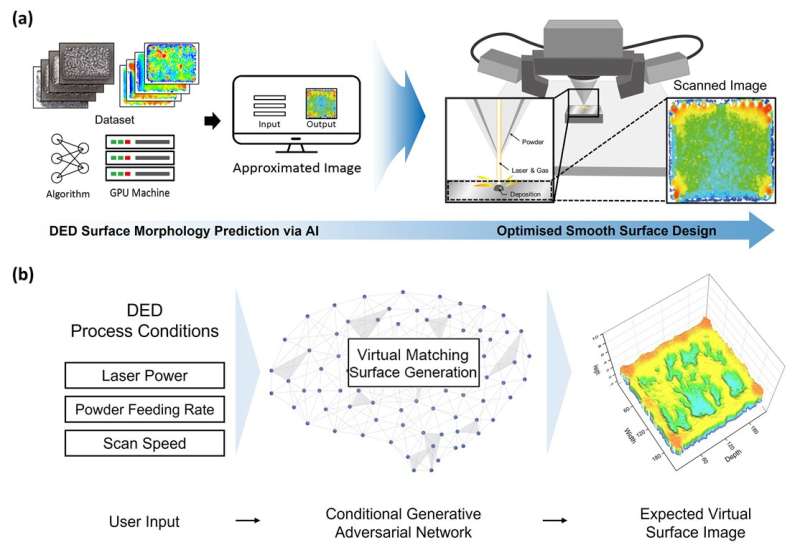Overview of (a) surface morphology prediction via AI and (b) the surface roughness prediction. A visualization of the expected virtual surface image suitable for the user input is generated by CGAN. Credit: UNIST
A recent study, jointly led by Professor Im Doo Jung in the Department of Mechanical Engineering at UNIST and Professor Hyokyung Sung from Kookmin University proposed a novel method with artificial intelligence (AI) to generate virtual surface morphology of Ti-6Al-4V parts by given process parameters.
In this study, the research team developed the CGAN-assisted surface morphology prediction method for Ti-6Al-4V DED parts by optimization of neural network structures. The experimental results and predictions illustrate the effectiveness of the developed CGAN model for choosing the optimal process conditions for manufacturing metal parts through AM, noted the research team.
According to the research team, with the help of the developed AI process with a high FID score, the virtual surface morphology images of the Ti-6Al-4V DED part were successfully generated from identical process conditions.
Their findings also revealed that the virtual surface of DED parts matches the printed metal surface well in terms of appearance and SEM analysis as well as quantitative study in microstructural analysis near the surface. Furthermore, the CGAN-assisted quick virtual surface generation and its corresponding Ti-6Al-4V DED part had an improved smooth surface with less lack of fusion or surface defects.
"[A] diverse range of DED process parameters can be quickly checked for their corresponding surface morphology with high accuracy by the developed AI," noted the research team. "The developed methodology using CGAN can also be used for further studies with side surface, edge, or curved surface morphology."
This study has been carried out in collaboration with Gyeongsang National University, Gyeongsang National University, and Carnegie Mellon University. Their findings have been published in Virtual and Physical Prototyping.
More information: Taekyeong Kim et al, Virtual surface morphology generation of Ti-6Al-4V directed energy deposition via conditional generative adversarial network, Virtual and Physical Prototyping (2022). DOI: 10.1080/17452759.2022.2124921
























